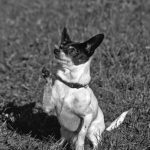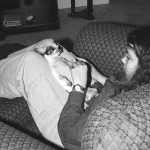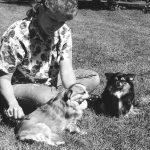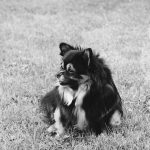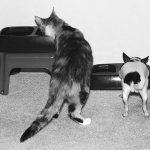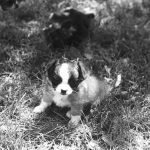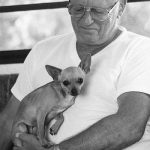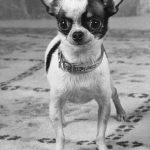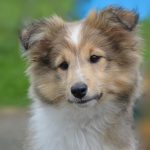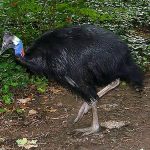In This Chapter
- Picturing the perfect Chihuahua
- Examining heads, tails, and other body parts
- Keeping perspective — nobody’s perfect!
Plenty of little dogs have compact bodies and expressive eyes (like the Toy breeds; see Chapter Perusing the Particulars of Chihuahua Charm), so what makes a Chihuahua unmistakably a Chihuahua? Details. A whole bunch of details combine to create a dog that looks and acts like a Chihuahua and nothing but a Chihuahua. This chapter focuses on appearances and gives you the official (honest!) description of Chihuahua perfection.
Look for Yourself: The Classic Chihuahua
You may already have a mental picture of a Chihuahua from watching the old television ads that show Gidget, the Taco Bell dog (see Figure 2-1), mouth his polite request for a little grub. Of course, I should have said her request because Gidget is, after all, a gal dog playing a guy, but that’s neither here nor there.
Next to its diminutive size, the Chihuahua’s most recognizable feature is its apple-domed head, which you can plainly see in Manchita in Figure 2-2. Attached to Manchita’s signature head are big eyes, brimming with intelligence and an inquiring gaze (Gidget’s gaze is intense), and erect ears, a bit bigger than you may expect, that add to her aspect of alertness. On top of many Chihuahua heads, practically invisible but easily discernable through touch, is the molera — a soft spot similar to the one found on newborn babies. The molera is also called the fontanel.
Figure 2-1: The head of the best-known Chihuahua on television. (Photo courtesy of Taco Bell Corp.)
A Chihuahua’s body is surprisingly sturdy. Although Manchita’s feet are dainty, her legs are muscular and swift. Her back is level, she’s a little longer than she is tall, and she carries her tail confidently — either in a semicircle or in a loop over her back.
Figure 2-2: Manchita presents the classic Chihuahua look: apple-shaped head, prominent leg muscles, level back, and confident tail.
The apple-shaped head and a few other features pretty much describe a Chihuahua’s distinctive appearance, but building a complete little superdog takes much more anatomy. Although knowing the details is important to successfully showing your Chihuahua (see Chapter
Training Your Chi for Canine Events, Tricks, and for Show), you don’t need to know the finer points to love and enjoy your pet. So, if you want details, stick with me. But if anatomy isn’t your thing, you can skip the following section.
Striving for the Picture-Perfect Chihuahua
Believe it or not, a blueprint exists for building a picture-perfect Chihuahua (and every other AKC registered breed). The blueprint is called the Official Standard for the Chihuahua. Of course, no dog is perfect (just as no person — not even a Miss America — is perfect), so no matter how charming a Chihuahua appears, the knowledgeable eyes of a good breeder or dog show judge always find room for improvement. Even the best breeders always have something to strive for.
Breed standards are serious stuff. Selecting breeding partners with the standard in mind is how breeders produce generation after generation of dogs that look and act like Chihuahuas. The best breeders try to produce dogs that come as close to matching the standard as possible, and dog-show judges select winners by comparing how closely each competitor matches its breed standard. (Head to Chapter
Training Your Chi for Canine Events, Tricks, and for Show for more info on dog competitions.)
In Figure 2-3, you see dog lingo describing the external features of the Chihuahua. This is a handy diagram to refer to as you cruise through the details in the following sections. Pretty soon, you’ll be able to speak the language of dog people — breeders, show exhibitors, and judges.
Just like schools, Chihuahuas have a parent groupEvery breed of dog that the American Kennel Club recognizes is backed by a national organization known as a parent club. Parent clubs educate owners and breeders and create the standards of excellence for their breeds. Respected breeders within the parent club write standards that the club membership must approve. The standards are created for the long term, and they seldom change. The parent club for the Chihuahua is the Chihuahua Club of America (CCA). What can reading the Chihuahua standard do for you? It helps you develop an eye for an excellent specimen and understand what makes the breed unique. The only problem: The standard is hard to follow because it was written as a guide for judges and breeders, who already understand dog lingo. Not to worry: Throughout the rest of this chapter, I translate the official talk into plain English. |
Figure 2-3: All the parts of the Chihuahua.
General appearance and demeanor
The Chihuahua is a graceful, alert, swift-moving, and compact little dog with a saucy expression and terrier-like qualities of temperament.
A Chi is compact, feels solid in your hands, and appears well proportioned. She isn’t long of body or lanky or too tall. Like a terrier, she’s confident, animated, spirited, curious, and interested in everything happening around her.
Size and proportion
A Chihuahua is a well-balanced little dog, weighing not more than 6 pounds (to qualify for the show ring). Her body is off-square, to quote the official standard — she should be slightly longer when measured from point of shoulder to point of buttocks than she is tall at the withers, or the top of her shoulders. Somewhat shorter bodies (in length) are preferred in males. A Chi’s height is the distance from the highest point of her withers to the floor; her length is the distance from the point of her shoulder to the point of her buttock. (Refer to Figure 2-3 to see all the technical terms applied to the dog.)
Technical Stuff
The reason a little more length is desired in females than it is in males is because females need the extra space to carry puppies.
A soft spot for ChihuahuasMany historians contend that the Chihuahua is a native Mexican breed (see Chapter Sharing Your Digs with a Dog: A Big Decision), but others argue that the breed originated in the Mediterranean — particularly on the island of Malta. According to proponents of the Malta theory, a tiny dog with a molera (a soft spot on its head — a trait unique to Chihuahuas) became established there and traveled on trading ships to European ports. To back up the theory, these historians point out that many paintings produced by European masters include small dogs resembling the Chihuahua. The most famous of these paintings is a fresco in the Sistine Chapel, created by Sondro Botticelli around 1482. Part of a series illustrating the life of Moses, Sons of Moses includes a little dog with a round head, big eyes, large erect ears, and other distinct Chihuahua characteristics. The painting was completed ten years before Columbus dropped anchor in the New World, so it’s a sure bet that Botticelli never saw or heard of a Mexican dog, yet he painted something incredibly close to a Chihuahua. Another theory contends that Chihuahuas originated in China and were brought to Mexico about 200 years ago. Supporters of this theory say that the Chinese were known for dwarfing plants and animals, and when wealthy Chinese merchants established homes in Mexico, they brought their little canine companions with them. |
A Chihuahua needs a balanced appearance. That means every part of its body must be in proportion with its other parts. If her legs appear too long for her body or her head appears too small for her neck, she will look like she’s made from spare parts. In general, many breeds are considered square, meaning that their height is the same as their length. But the Chihuahua is supposed to be just a little longer than it is tall.
Head
To meet the standard, the shape of a Chihuahua’s head should look sort of like an apple — rounded but not completely round. If she has a molera, you’ll feel a slight indentation, like the soft spot on a baby’s skull, when you gently stroke the top of her head. Breeders prefer eyes to be large, set well apart, radiant, and shiny — not close together, protruding, smallish, or dull. For perfect proportions, the middle of the eyes lines up with the lowest part of the ears. The following sections break down the rest of the head.
Ears
If a Chi has ideal ears, they’ll be at a 45-degree angle to her head when she’s resting, but they’ll come to attention, held high, when she’s alert. She may flatten them against her skull when she’s moving fast or when something makes her uneasy.
Technical Stuff
How a dog holds its ears (for example, alertly erect or relaxed) is called its ear carriage.
Warning!
Chihuahua ears must be left as nature made them. Cropped ears (surgically shaped or shortened ears) aren’t permitted on Chihuahuas in the show ring. And broken ear cartilage, resulting in a droopy or lopsided ear, is grounds for disqualification from showing.
Muzzle (snout)
The standard calls for a muzzle, or snout, that’s moderately short, but that doesn’t mean shorter is better. A super-short muzzle is incorrect in the Chihuahua, because extremely short muzzles can cause breathing problems and crowd the teeth. Ideally, the muzzle should emerge from the skull at a right angle.
Teeth
If a Chi’s upper-front teeth meet tightly outside her lower-front teeth, she has a scissors bite; if her upper and lower incisors (front teeth) meet flush with each other when her mouth is closed, her bite is level. The scissors bite is the strongest bite and is considered ideal. The teeth wear down faster when the bite is level.
Neck, topline, and body
An attractive neck from a side view flows smoothly and gracefully into your Chihuahua’s withers without wrinkles or folds. Ideally, her neck is of medium length. Too short of a neck may be the result of improperly placed shoulder blades, which prevent her from moving well (see the section “Gait” later in this chapter). If her head appears to be attached directly to her shoulders, she’ll look unbalanced and front-heavy.
On the other hand, an extremely long neck may be a sign that she lacks substance (appears weak). It may be accompanied by toolong legs and a lanky body. You should look for graceful lines. All the dog’s parts should be well balanced in relation to one another.
A Chi’s topline flows along the top of her back from the withers to the root of her tail (where the tail meets the body). Ideally, it should be level or straight, without a dip in the middle or a downward or upward slope. Her body should appear rounded rather than flat along the sides; she needs a roomy rib cage to house her heart and lungs.
Technical Stuff
A dog’s conformation is the shape of her body from the top of her head to the tips of her toes and tail. It encompasses balanced body proportions and size, both of which need to be correct for the breed.
Tail
Figure 2-4 illustrates the Chihuahua’s three correct tail positions and presents what a sorry tail tuck looks like. When a Chihuahua puts its tail between its legs, something is wrong. The dog may be timid, frightened, cold, or sick. Note: A cropped tail or bobtail disqualifies a dog from the show ring.
Forequarters
Well-laid-back shoulder blades are important in a Chihuahua. (Sloping shoulders can also be described as well-laid-back.) That means her shoulder blade, or scapula, connects her upper-arm bone with her vertebrae with an obvious backward slope from its bottom end (at the arm) to its top (just in front of the withers). Why are well-laid-back shoulder blades important? Because sloping shoulder blades allow a Chi’s front legs to have a good range of motion. Shoulders that lack this slope are called straight shoulders. They’re faulty because the upper end of the shoulder blade is too far forward — crammed right into the dog’s neck. Besides making the neck look too short, straight shoulder blades shorten a dog’s gait by limiting the forward reach of her front legs.
Here are some more forequarter considerations on the Chihuahua:
– Ideally, a Chihuahua’s front legs should be straight while her toes point forward. Being bowlegged is a fault, as is an eastwest front (toes pointing to either side) or toeing in (toes pointing toward each other).
-Feet that are elongated like a rabbit’s foot or rounded like a cat’s paw aren’t desirable. Instead, her feet need to reach a happy medium between the two, with her toes separated but not splayed (flat and spread apart).
– The pasterns are the lowest points on a Chi’s front legs, just above her feet. They need to be slender and straight.
Figure 2-4: Three correct tail positions — and one sorry tail tuck.
Hindquarters
To give you a little taste of dog talk, the perfect Chihuahua’s rear end is officially described as “Muscular, with hocks well apart, neither out nor in, well let down, firm and sturdy. The feet are as in front.” Have you got that? Well the first word, “muscular,” is obvious, and what the rest of it means is that a Chihuahua’s hind leg has an upper and lower thigh, separated by the stifle, or knee joint, which is located on the frontal part of the dog’s hind leg (don’t forget Figure 2-3). The upper and lower thighs need to have sufficient muscle. Between the stifle joint and the foot is the hock joint. Hock joints that are much lower than the middle of the hind leg are better. Well let down means the hock joint is rather close to the ground.
Rear legs that are absolutely parallel when viewed from behind are ideal. Hocks turning toward each other, known as cowhocks, and hocks turned outward (bowed or spread) are faulty.
Coat
Chihuahuas come in two varieties — smooth coat and long coat. If a Chi has a smooth coat, her hair is short and close to her body, and she may or may not have an undercoat — a protective layer of shorter fur underneath the outer or top coat. A smooth Chihuahua that has an undercoat appears more thickly coated and usually has a furrier tail and a ruff of thicker hair around its neck. If a Chi has no undercoat, her hair is sparser. In fact, it may be so thin that she appears nearly bald on parts of her head, ears, chest, and belly.
If a Chi is long coated, she has an undercoat, and her outer coat is between 1 inch and 1 1⁄2 inch long. She also has the following characteristics:
- Her ears are decorated with longish hair called fringe or feathering.
- She has an abundant ruff around her neck.
- She has long hair called a plume on her tail.
- She has wispy hair on the back of her legs.
- She sports natural pants — long hair on her buttocks.
Aside from that, she should look exactly like a smooth Chihuahua, because the two varieties have exactly the same conformation (body structure) underneath their coats. (For more on coats, jump to Chapter
Perusing the Particulars of Chihuahua Charm.)
Technical Stuff
A sparse coat disqualifies only long-coated Chihuahuas from the show ring. Short-coated dogs with thin hair are considered normal, although a thicker coat usually is more attractive.
Color
Remember
Any color — solid, marked, or splashed, take your pick — and all combinations of colors and markings are acceptable in Chihuahuas. None are considered better or worse than others.
Gait
If you walk at a normal pace, a Chihuahua should easily be able to keep up with you by moving along at a smart trot. When she gaits properly, she wastes no motion — no high-stepping hackney or goose steps. Her feet don’t turn in toward each other or wing out to the side. In fact, her movement is lively but effortless, and only her legs are involved. Her back (topline in dog lingo) should remain level and not roll from side to side, bob up and down, or appear concave (dip in the topline) or convex (roached back).
Tip
One way to check your Chi’s movement is to watch while someone else trots her squarely toward you and away from you on a leash. If her movements are ideal, you’ll see only her front legs as she approaches you and only her rear legs as she moves away. While watching her from the side, her front legs should reach out but stay close to the ground, and her rear legs (which actually power the dog) should have good drive. None of her legs should interfere with each other. If you’re not sure about rear drive, watch her trot away from you again. Can you see the pads of her back feet? If so, she probably has plenty of drive.
Technical Stuff
When a Chihuahua stands relaxed, her front feet may turn ever so slightly away from each other, toward either side, and still be correct. In fact, if they point perfectly in front when the dog is in a casual stance, chances are they’ll point toward each other (toe in) rather than straight ahead when the dog moves.
Temperament
A Chihuahua should be bright, bold, and saucy, but that’s just the gist of it. Chihuahua temperament deserves a full chapter, not a paragraph. Read all about it in Chapter
Perusing the Particulars of Chihuahua Charm.
What if Manchita Doesn’t Match the Standard?
To be honest with you, the real Manchita misses out on matching the breed standard in several places. (You can’t see Manchita’s faults in Figure 2-3. The picture was taken before she developed them.) Yet, she’s happy, healthy, and pushing 12 years old, with the attitude and energy of a puppy. Her bite is wrong, but she chews just fine. She’s fiddle-fronted (bowlegged with her toes turned out), but she’s agile and likes going for brisk walks. If you’ve just read about the Chihuahua standard and discovered that your precious pet isn’t perfect, don’t worry. As long as her faults don’t affect her health and mobility, only a top breeder or judge will know or care.
The truth is, no dog — not even an AKC Champion — matches every word of the standard. Show dogs just have to come pretty close, or their careers end early.
Remember
Naturally, it’s most important that dogs used for breeding comply with the standard, because their quality is reflected in the next generation. Breeding to its own standard is what makes each breed of dog unique. If breeders ignore the details, soon Chihuahuas, Papillons, Miniature Pinschers, and other Toy dogs will resemble each other, and the individual breeds will gradually fade away. Chapter Choosing Your Ideal Chihuahua covers the ins and outs of choosing a breeder, and Chapter Ten Questions to Ask Chihuahua Breeders provides questions you can ask a breeder to make sure he or she has taken the proper steps to produce the best dogs.
by Jacqueline O’Neil











